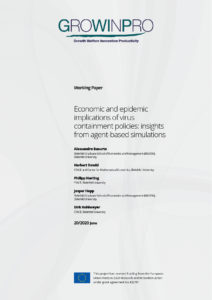This paper analyzes the implications of different designs of policies, which aim to contain the diffusion of the SARS-CoV-2 virus, with respect to induced economic loss and virus mortality. An agent-based simulation model is implemented and calibrated with German data, which combines the representation of a simple multi-sectoral closed economy with the explicit incorporation of virus transmission channels at the workplace, during shopping activities and other social contacts. It is demonstrated that under a policy resembling German containment measures the model closely reproduces the dynamics of pandemic and economic variables in the aftermath of the COVID-19 outbreak in Germany. Exploring alternative policy designs shows that any efficient policy should impose a low threshold of newly infected for moving from the lock-down to the opening-up stage and in the opening-up stage all restrictions on economic activity should be lifted. With respect to the reduction of consumption activities during the lock-down a trade-off between the induced GDP loss and the resulting mortality emerges. Regardless of the chosen design of the containment measures, the introduc- tion of complementary economic support measures substantially reduces the induced GDP loss and leads to a reduction of the public debt accumulated during the considered time interval. The efficient design of containment policies changes substantially if lifting economic restrictions during the opening-up stage also results in reduced effectiveness of the individual prevention measures by agents.

